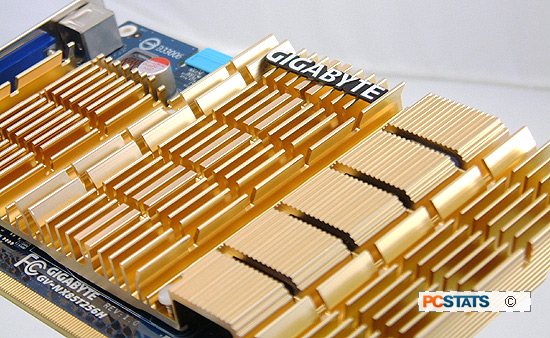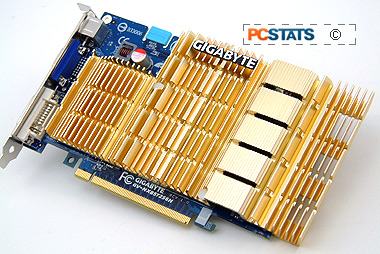 Gigabyte's GV-NX85T256H GeForce 8500GT
videocard is based on nVidia's 'G86' GPU, which is built on TSMC's 80nm
manufacturing process.
Gigabyte's GV-NX85T256H GeForce 8500GT
videocard is based on nVidia's 'G86' GPU, which is built on TSMC's 80nm
manufacturing process.
The chip contains a moderate 210 million
transistors. According to nVIDIA, the G86 is rated to draw a maximum of 43W of power, well
below the limit of what a PCI Express x16 slot provides.
The GeForce 8500GT GPU has a default clock speed of 450 MHz. The difference
between the nVIDIA G86 core and the G84 found in the GeForce 8600 series is the
number of stream processors available. With the GeForce 8500GT GPU, there are
only 16 stream processors while the G86 has 32 SPs and the G80 has 96/128.
Essentially that means that the GeForce 8500GT has half the rendering power
of the GeForce 8600 series.
The nVIDIA GeForce 8500GT GPU can be equipped with either 256MB or 512MB of
memory, this Gigabyte Geforce 8500GT has 256MB. Memory runs at 800 MHz on a 128bit
memory controller bus. The relatively low memory operating frequency, teamed up
with the narrow memory bus width, tells us that high resolutions and enhanced
visual effects like Anti-Aliasing and Anisotropic Filtering are too much for
this GPU.
While the G86 core carries onward with
nVidia's current thinking of how a graphics processor should be built, there are
a few notable changes from the G80. Gone are the hard coded Vertex and pixel
shaders, they've been replaced with a more flexible Stream Processor (or unified
shader) that calculates both types of data. The Stream Processors runs at 900
MHz incidently. Traditional core clock speeds as we know it are dead, as several
internal processors are running at different speeds.
Each Thread Processor has two groups of
eight Stream Processors, and each group talks to an exclusive texture address
filter unit as well as well as being connected to the shared L1 cache. When more
memory is needed, the Thread Processor connects to the crossbar memory
controller. nVIDIA's crossbar memory controller is broken up into two 64 bit
chunks for a total bus width of 128 bits. By moving the GPU towards a threaded
design, the nvidia G86 is much more like a processor than any graphics core of
the past. Any type of data - be it pixel, vertex, or geometry shader can be
processed within the Stream Processor. This allows load balancing to occur
between the various tasks.
And now, on with the overclocking!
Overclocking the passively
cooled Gigabyte videocard:
 |
| Overclocking Results: |
|
|
The Gigabyte GV-NX85T256H videocard is really not intended to be overclocked heavily, but that doesn't mean it'll be spared from PCSTATS overclocking tests. ;-) By default the core is clocked at 500 MHz, the memory at 800 MHz.
Starting with the G86 core first the  clock speed was increased in slow 10 MHz increments. The GeForce 8500GT core handled overclocking pretty well and passed 550 and even 600 MHz without much difficulty! The core reached a top speed of 650 MHz, but anything higher caused it to act up while running benchmarks. I believe heat may be an issue as the heatsink was very hot and core temps registered in the high 60s.
clock speed was increased in slow 10 MHz increments. The GeForce 8500GT core handled overclocking pretty well and passed 550 and even 600 MHz without much difficulty! The core reached a top speed of 650 MHz, but anything higher caused it to act up while running benchmarks. I believe heat may be an issue as the heatsink was very hot and core temps registered in the high 60s.
With that in mind, if you are planning to overclock the Gigabyte GV-NX85T256H, make sure you have good system airflow in your case! Keep that big aluminum heatsink cool...
Next up was the GDDR2 memory, starting at 800 MHz, we were hoping to crack the 1000 MHz barrier. Increasing the memory frequency in 20 MHz steps, PCSTATS was able to push the memory speed to 900 MHz and eventually 1000 MHz. Success! In the end the memory reached a maximum speed of 1022 MHz.
Now, on with the benchmarks...
